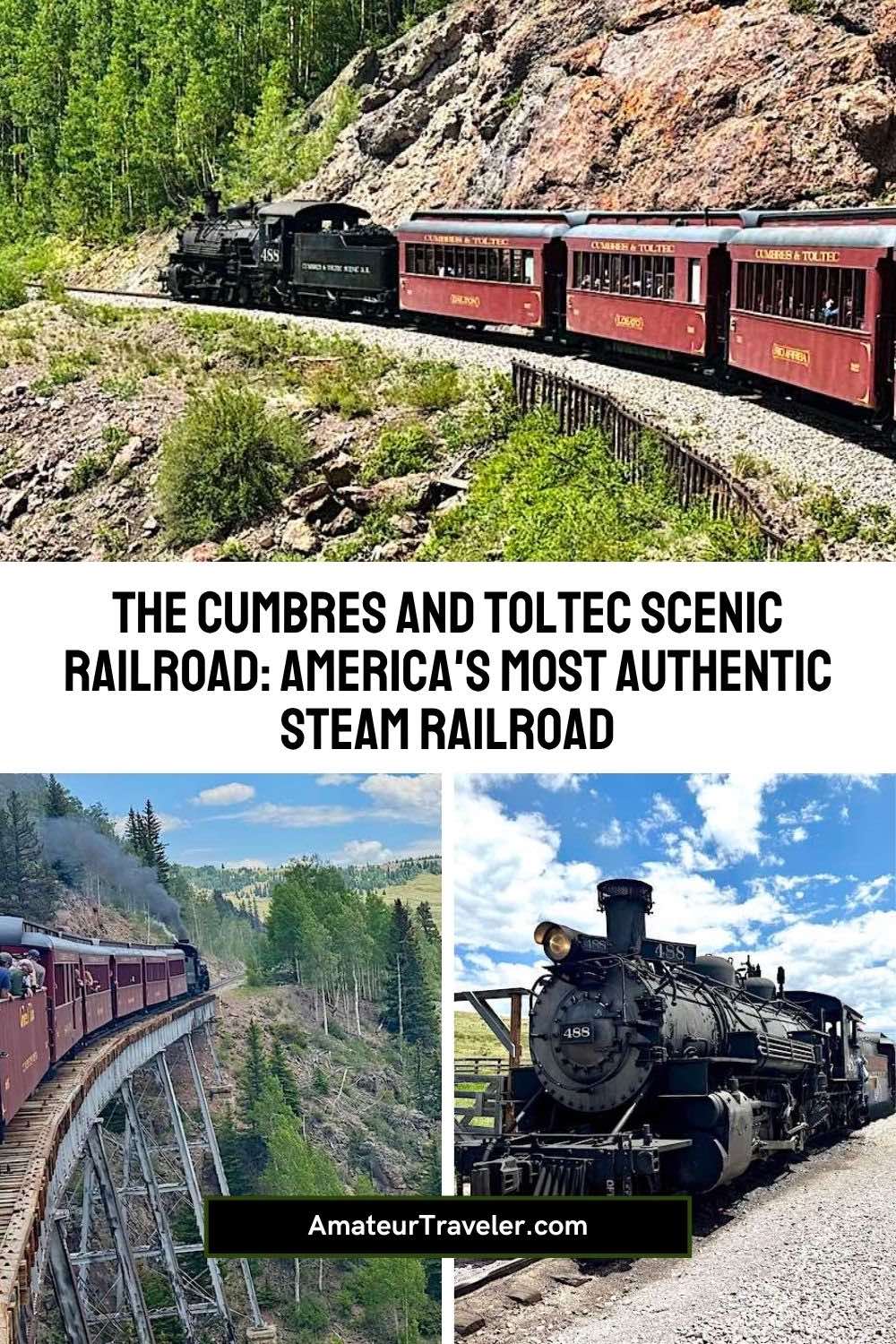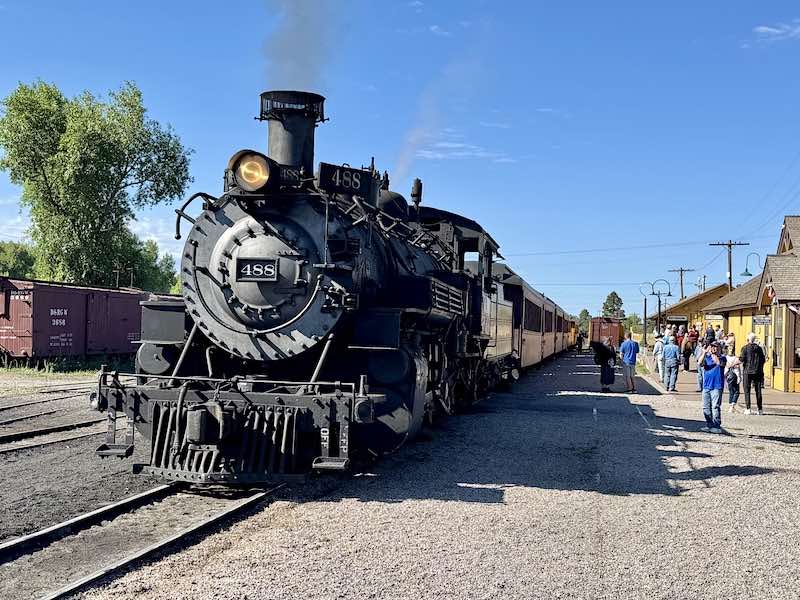The Cumbres and Toltec Scenic Railroad: America’s Most Authentic Steam Railroad


Situated in the northern region of central New Mexico and stretching across the border into southern Colorado is a narrow-gauge heritage railroad that played a crucial role in the development of the Western United States by providing access to remote regions for settlers and industries. The Cumbres and Toltec Scenic Railroad has been in operation since 1860 and stands as one of the most outstanding examples of a steam‑powered heritage railroad in the United States.
A heritage railroad is a functioning railway that aims to recreate the experience of traveling on a historic train from the past or to experience a historic railway line. Ideally, a historic railroad should offer riders the experience of rail transport during a specific historical period.


Steam Engine 488 pulling the passenger cars up the 4 percent grade towards Cumbres Pass
For more than 145 years, the Cumbres and Toltec Scenic Railroad has offered passengers the opportunity to witness the stunning landscapes of the San Juan Mountains while enjoying the excitement of a steam-powered locomotive traversing narrow passes, rock-carved tunnels, and dramatic elevation changes. The railroad derives its name from two geographical landmarks along the route: the 10,015-foot (3,053 m) high Cumbres Pass and the Toltec Gorge. Notably, because of its authenticity and dedication to preserving history, the Cumbres and Toltec Scenic Railroad has received recognition as a National Historic Landmark, a New Mexico State Registered Historic Site, and a National Civil Engineering Historic Landmark.


The Parlor Car at the end of the train, immediately before departure at Ozier Station
My Journey Begins
I take great pleasure in riding steam excursion trains, and I have yearned to experience the Cumbres and Toltec Scenic Railroad for many years. The primary challenge for me has been its location.
Although the railroad is situated approximately 100 miles north of Albuquerque, New Mexico, I have never had the opportunity to visit that area of the United States. Eager to ride the train, I created a travel plan that enabled me to drive to the location from Las Vegas.
Given that it was a 10‑hour journey, I also planned stops at various attractions along the route, including Meteor Crater, the Petrified Forest National Park, the Painted Desert, and the New Mexico Badlands. Besides riding the Cumbres and Toltec Scenic Railroad, I also arranged an excursion on the Durango and Silverton Heritage Railway, which is located about 3 hours away in southern Colorado.
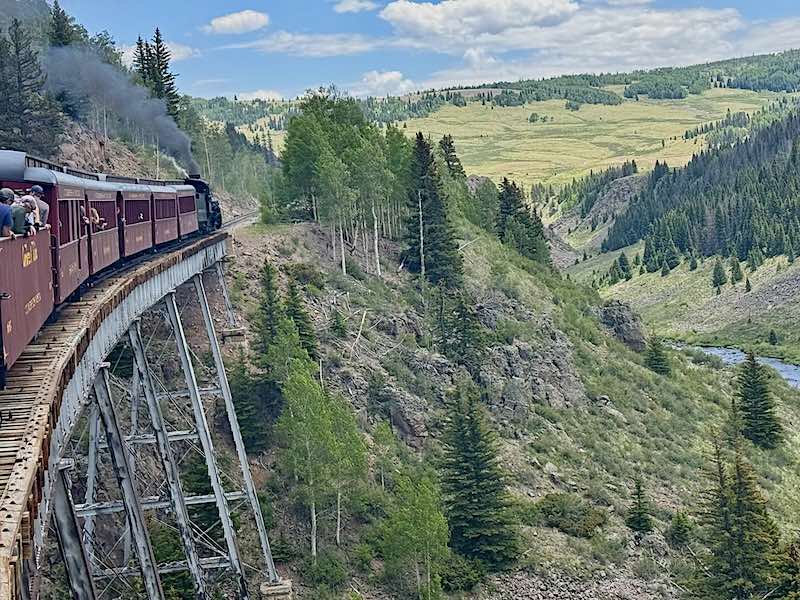

Cascade Trestle, the highest trestle on the Cumbres and Toltec Scenic Railroad
Building the Railroad
The current Cumbres and Toltec Scenic Rail Line spans a 64‑mile (103 km) section of the San Juan Mountain extension of the larger Denver & Rio Grande Railway (D&RGR), which subsequently became known as the Denver & Rio Grande Western Railroad, or simply the “Rio Grande.” The construction of this railroad commenced in 1880 from Antonito, Colorado, with the aim of serving the flourishing mining towns in southwestern Colorado. Within a mere 10 months, the initial segment of the railroad was constructed adjacent to the Toltec Gorge and across the 10,015‑foot (3,053 m) Cumbres Pass at a 4 percent grade into Chama.
Following its completion, the railroad played a vital role in transporting the region’s natural resources, including various ores, timber, oil, cattle, and sheep. From its inception, it also facilitated passenger travel to and from the area.
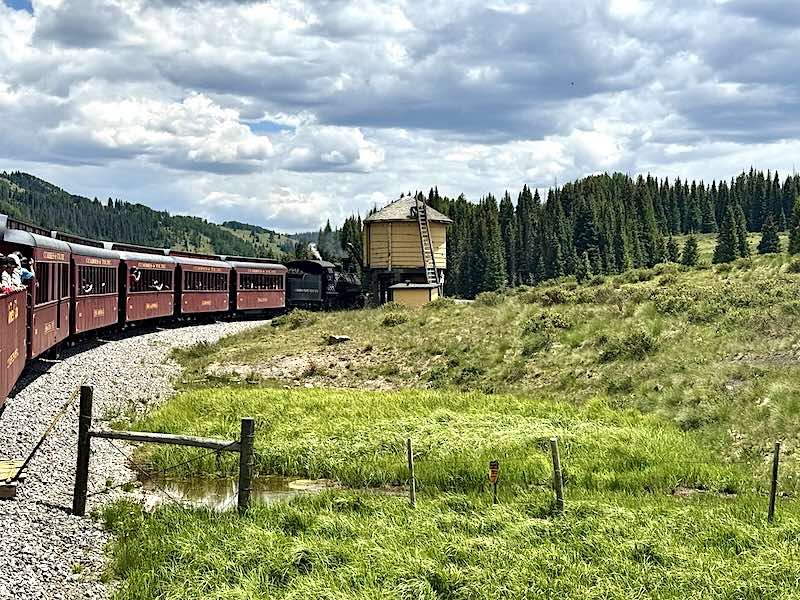

The Cumbres and Toltec Scenic Railroad taking on water at the Los Pinos Water Tank
Why Steam Matters
Numerous heritage railroads provide scenic train rides powered by either steam or diesel locomotives. Personally, I favor steam engines because of the nostalgic experience they offer. Steam engines are noisy, loud, and often seem human‑like in their rhythmic and coordinated movements.
The power of steam locomotives is evident in the hissing and chugging sounds produced by the steam that drives them along the tracks. The rides are rarely smooth, with the coaches swaying and jerking from side to side. Navigating through a train can be quite challenging, as it constantly lurches and sways.
For me, this is the joy of the ride. Steam train enthusiasts treasure these excursions and actively seek out genuine experiences such as the Cumbres and Toltec Scenic Railroad.
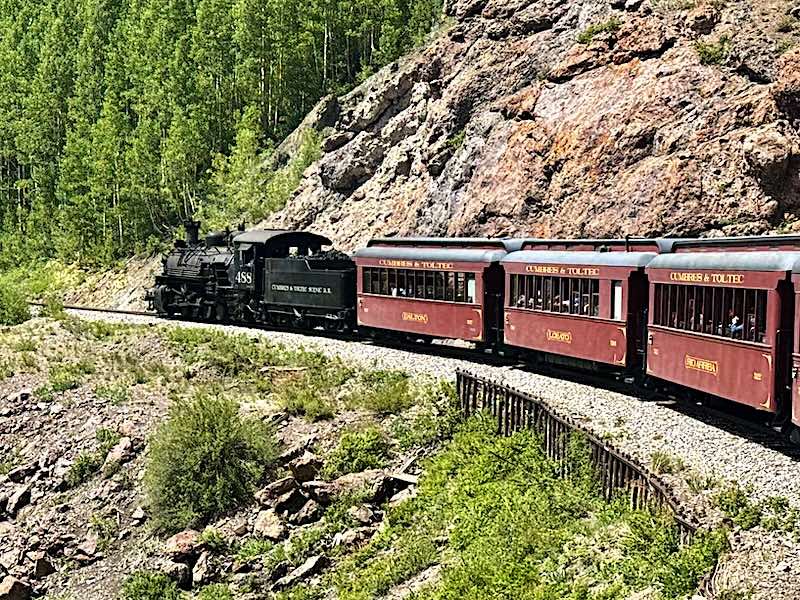

The Cumbres and Toltec Scenic Railroad crossing over the rock ledge at Windy Point
The Narrow‑Gauge Difference
Since the Cumbres and Toltec Scenic Railroad is a narrow‑gauge railway, its constant movement and ability to make tighter turns further enhance the thrill of the journey. Narrow‑gauge railways generally feature rails spaced approximately 3 feet apart, in contrast to standard‑gauge railways, which have a distance of 4 feet 8.5 inches between rails.
Due to their broader base, standard‑gauge railways offer greater stability.
Narrow‑gauge railroads were more prevalent in the Western United States due to their ability to maneuver through tighter curves in mountainous and rugged landscapes. Operating at slower speeds, narrow‑gauge railroads support smaller trains and were usually more economically affordable to build.


Planning in Chama
Chama, New Mexico, a quaint town with a population of approximately 1000 residents, served as the starting point for my rail journey. I conducted thorough research online and made as many reservations as possible in advance. Due to the limited availability of accommodations and dining options in Chama, careful planning is crucial.
The majority of the town is centered around the railroad, which operates from late May until mid‑October. The area experiences warm summers and frigid winters, due to its high altitude in the Southern Rocky Mountains. During the winter months, snowfall is prevalent, averaging 103 inches annually.


The interior of Chama Station
Although the railroad once functioned year‑round, tourist excursions are now limited to the late spring through early fall. I secured my ticket for a full‑day excursion months in advance, which commenced at the Chama train station.
Excursion Logistics
Every day, the Cumbres and Toltec Scenic Railroad conducts tourist excursions with two trains (one traveling in each direction) that depart in the morning from Antonito, Colorado, and Chama, New Mexico. Passengers have the option to board at either station. Both trains converge at Osier, Colorado, where a meal is provided to passengers in a contemporary dining hall.
From this point, riders may choose to proceed to the opposite end of the railroad or return to their original station. My itinerary for the day included first boarding a bus that would take about an hour to reach the train station in Antonito, Colorado. From there, I was scheduled to board a train heading to Osier, Colorado.
Following a lunch break in Osier, I would then board another train for my return journey to Chama. This choice can also be made in reverse; however, I found it preferable to take the bus ride first and then enjoy the complete railroad journey of 64 miles (103 km) for the remainder of my trip.
Mechanical Setbacks
As a traveler in pursuit of adventure on heritage railroads, I understand that plans do not always unfold as intended.
Upon my arrival at the station in Chama, I discovered that the locomotive scheduled to depart from Antonito had encountered mechanical issues the day before and needed to be taken to the shop for repairs; consequently, there would be no journey from Antonito to Ozier. I am aware that today’s coal‑fired steam locomotive engines belong to an aging fleet.
Numerous locomotives are over a century old and remain operational solely due to the dedicated care provided by mechanics and engineers committed to maintaining their functionality. These trains are prone to breakdowns, and repairing them is consistently a challenge. There is no such thing as a standard part, and nearly every repair necessitates a significant level of customization.
Frequently, repairs must be sent to specialized machine shops due to the limited number of skilled mechanics.
Furthermore, it is crucial to acknowledge that antique steam locomotives also require regular maintenance and must comply with all federal regulations enacted over the years. It stands as a testament to the engineering prowess and the dedication of the staff that they continue to operate and provide service with such reliability.


The lower region of the Toltec Gorge formed by the Rio de Los Pinos
Adjusting Expectations
Despite being aware of all this, I still felt a sense of disappointment, as numerous reviews indicated that the most picturesque portion of the excursion was the 37.7‑mile (60.7 km) stretch between Antonito and Ozier, renowned for its numerous curves, tunnels, and breathtaking views of the Toltec Gorge while ascending Ozier Mountain.
This segment of the railway crosses back and forth between Colorado and New Mexico ten times. To make up for the alteration in my plans, I was presented with the option to travel by train from Chama to Ozier and then return on the same train to Chama.
The 25.7‑mile (41.4 km) journey from Chama to Ozier also features many scenic attractions, including several curves and a remarkable ascent of over 2,150 feet (655 m) in elevation to reach the railroad’s highest point at 10,015 feet (3,053 m) above sea level.
I agreed to the change since I had traveled a considerable distance to arrive there, and I was very eager to experience the railroad.
Although I had to wait an additional hour for the train to commence its journey, this also provided me with the opportunity to converse with the staff and my fellow passengers.
Waiting at the Station
When I embark on a rail journey, I prefer to arrive at the station approximately one hour before my scheduled departure, as I take pleasure in watching the crew prepare the train. I find it captivating to see the station house come alive with activity and the flurry of preparations underway. I am also aware that it requires several hours to ignite a steam engine and make it operational.
This process involves starting the fire, securing water for the boiler, and loading coal into its designated car. I genuinely relish the excitement of the steam engine’s arrival, the shrill sound of its whistle signaling its presence, and the rhythmic ringing of the bell warning onlookers to clear the way. Steam seems to hiss from every valve of the locomotive, and the internal power of the engine can be felt as dark, thick clouds billow from the smokestack.
Rail enthusiasts rush to witness the engine’s first appearance, gathering near the tracks to experience the locomotive maneuver into position with the passenger cars in anticipation of the journey. Once the engine is in place and coupled to the train with a resounding thud, the locomotive starts to release steam, and the engine gradually settles down and comes to rest. Once the locomotive was coupled, I made an effort to converse with the engineer and capture photographs of the engine from the front.
I derived great satisfaction in being the last passenger to board my coach.


Steam Engine 488
For my excursion, Steam Engine 488 proudly took its place at the front of the train, ready to lead us on our adventure. Constructed by the Baldwin Locomotive Works near Philadelphia in 1925 and purchased by the Denver and Rio Grande Western Railroad, Engine 488 featured a 2‑8‑2 wheel arrangement, indicating that the train consisted of two leading wheels on one axle, eight powered driving wheels distributed across four axles, and two trailing wheels on another axle. The leading wheels enhance stability and assist the locomotive in navigating curves, while the eight driving wheels deliver substantial pulling power, and the trailing wheels bear the weight of the firebox, enabling the engine to attain higher speeds and improved stability.
This wheel arrangement is commonly known as a Mikado, named after the well‑known Gilbert and Sullivan opera, originally referencing a series of engines constructed for the Nippon Railway in Japan. This configuration was particularly suitable for the types of loads transported on the Cumbres and Toltec Railway, which included passengers and heavy natural resources across diverse terrains featuring numerous curves and elevation changes.


The interior of a coach passenger car on the Toltec and Cumbres Scenic Railroad
Departure and Onboard Experience
My journey departed from Chama Station at approximately 9:30 am, with the conductor grandly announcing, “All Aboard.” As we departed the station, all the staff and volunteers gathered to wave goodbye and wish us a safe trip. Numerous groups and a diverse array of passengers from various regions of the country were present for the excursion.
Some passengers were taking the complete return journey, while many opted to travel only to Ozier and then return by bus from Cumbres Station for a half‑day adventure. Travelers have choices regarding the type of rail car they can utilize, based on their preferred class of service. The majority of passengers select a coach car, which also provides access to an open‑air car.
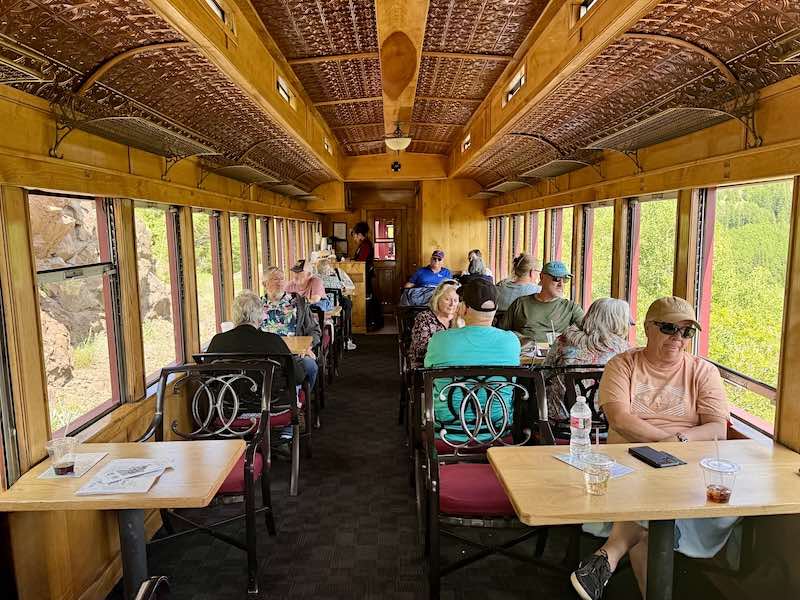

The Deluxe passenger car with tables on the Toltec and Cumbres Scenic Railroad
These open‑air cars are favored as they allow passengers to move in and out to capture photographs and observe wildlife. Additionally, passengers can visit a concession car where they can buy beverages and snacks. The Deluxe car offers cafe‑style seating, providing passengers with extra space and the chance to converse with fellow travelers.
Those who opt for this premium service also receive snacks and souvenirs adorned with the Cumbres & Toltec logo.
Furthermore, Deluxe car passengers also have access to an open‑air gondola.


The concession car on the Toltec and Cumbres Scenic Railroad
Riding the Parlor Car
The premium service I selected was the costliest. The Parlor Car emulates the Victorian period when railroads featured exclusive cars designed for dignitaries like railroad magnates and mining tycoons. This car was configured so that every passenger had access to their own panoramic window.
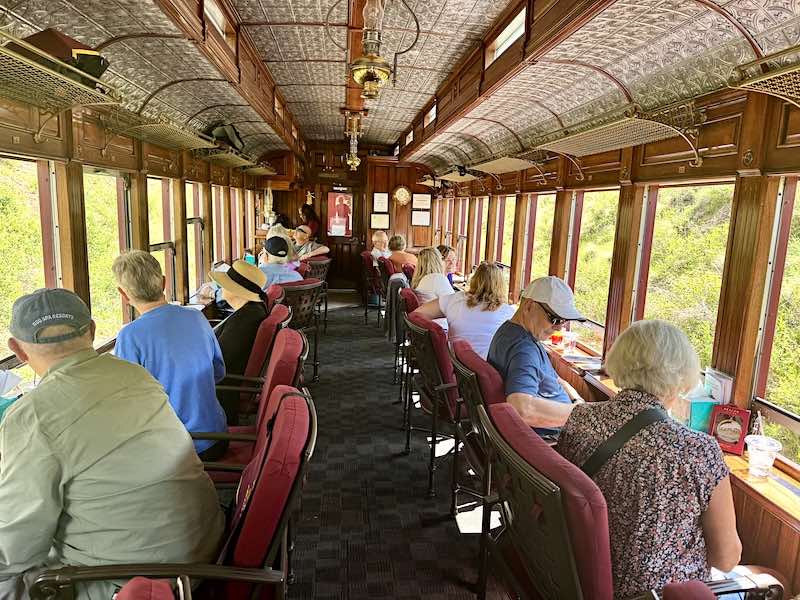

The Victorian-style Parlor car on the Toltec and Cumbres Scenic Railroad
Along with snacks and drinks, each passenger was also given an embroidered logo bag/backpack and a holiday ornament. All cars, irrespective of the service level, were attended by a docent who offered an engaging narrative along with the history of the railroad and the surrounding area. I opted for a Parlor car because I desired comfort for the 7‑hour 45‑minute trip.
Additionally, I wanted the freedom to capture photographs from my own private window at the rear of the train. Furthermore, since the Parlor Car was the final rail car, it featured its own dedicated private viewing platform. Admittedly, I also appreciated the enhanced level of service.


A summer camping yurt seen from the train in the forests outside of Chama, New Mexico
Ascent Through Forest and Valleys
The initial segment of the journey began with a gradual ascent through a picturesque forest located north of Chama. Among the trees, we spotted nature parks, hiking areas, campgrounds, and even a yurt. We quickly arrived at the Lobato Trestle, a deck girder bridge spanning Wolf Creek, recognized as the second‑highest bridge along the route.
What is particularly intriguing about scenic excursions on heritage railroads is that each landmark encountered tends to acquire a legendary significance, often tied to some historical event associated with the line. For instance, the Lobato Trestle was destroyed by fire in 2010 under mysterious circumstances, the details of which remain unresolved to this day. To the average observer, the trestle may simply seem like a bridge over a creek, yet in the realm of railroad lore, it stands as a significant landmark along the journey.
Beyond the trestle, the scenery unfolds into expansive valleys adorned with breathtaking views that appear to extend infinitely. At various intervals, the train crossed roadways where motorists paused to wave at the passengers. Numerous vehicles trail the train along adjacent roads, capturing videos and photographs of the train as it steadily ascends towards Cumbres Pass.


Steam Engine 488 pulling multiple passengers towards Windy Pass
Climbing to Cumbres Pass
The significant highlight during the journey from Chama to Ozier is the steady upward climb, frequently at a 4 percent incline, leading to Cumbres Pass. With the mountains looming above us, I noticed a rock ledge carved into the mountainside and found it difficult to believe that we would soon climb that high and traverse along the face of the mountain. Gradually and consistently, we progressed towards the rocky ledge aptly named Windy Point, due to the cooler temperatures and winds sweeping across the rock face.
The vistas were breathtaking, and I came to the realization that the ride was more stunning than I had anticipated. At this point, we listened to our docent recount tales of how these regions have endured over 20 feet of snow in recent winters. In the past, railroad families had to weather the storms until the tracks were cleared for travel.


Windy Point, where train tracks traverse a rock face carved into the face of a cliff
After clearing Windy Point, we entered Cumbres Pass and soon made a brief stop to collect passengers at Cumbres Station, the highest point along the railway at an elevation of 10,015 feet (3,053 m) above sea level.
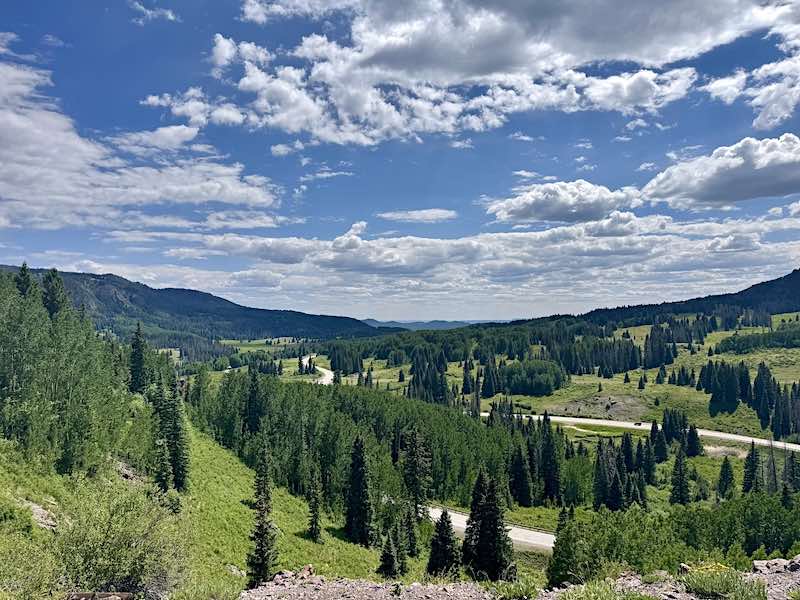

Winding and looping railroad tracks as the train approaches Tanglefoot Curve
Descent to Meadows
After our stop, the train started a gradual descent through lengthy, winding turns into mountain meadows and elevated valleys. These long, winding curves, such as Tanglefoot, enabled the train to alter its elevation. Even in the present day, brakemen examine the train to ensure that the brakes and bearings do not overheat as it travels downhill.
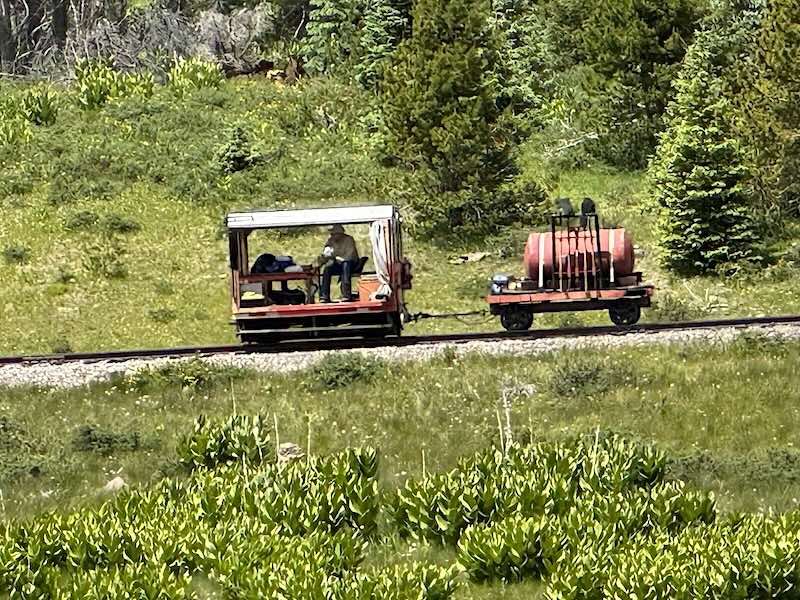

A Speeder following the train and looking for hot ash and sparks
Another unexpected sight around the Tanglefoot Curve was a small motorized railcar called a speeder, patrolling behind the train. This vehicle’s purpose was to detect any potential sparks or hot ash from the steam train and extinguish them before they could ignite forest fires. Our attendant also noted that these railcars are frequently utilized to recover items dropped by passengers who lean out of the side windows to take photographs.


An open-air viewing platform car on the Toltec and Cumbres Scenic Railroad
Approaching Osier
The concluding section to Ozier was filled with both beauty and unexpected delights. Following a brief pause to replenish the train engine’s water supply from a classic elevated railroad water tower, we traversed an alpine meadow dotted with remote summer residences. As our journey progressed, we soon crossed the Río de Los Pinos, where we observed anglers engaged in fly fishing, and continued onward towards a small creek, where we traversed the 137‑foot Cascade Trestle, the tallest trestle along the route.
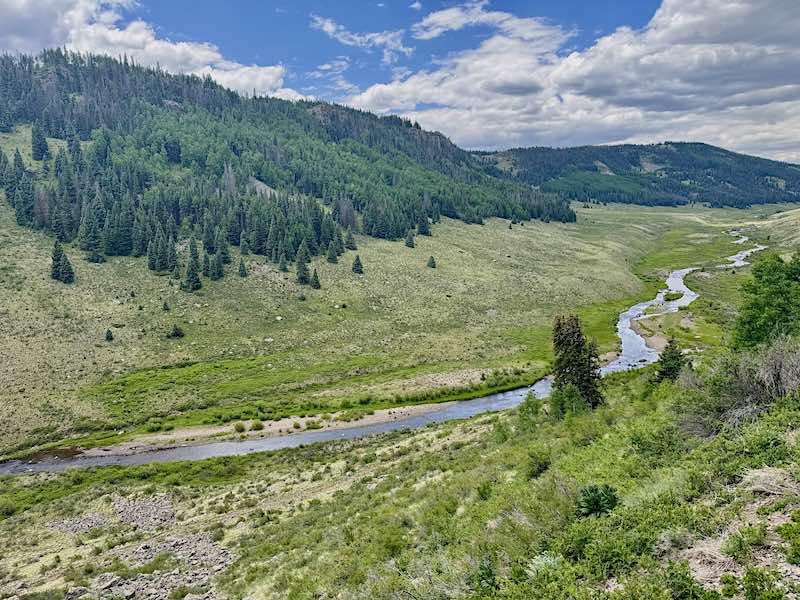

The Rio de Los Pinos meandering towards Ozier, Colorado
As we rounded a long, gentle curve leading to the former small settlement of Ozier, our lunch stop, we also had a stunning view of the Río de Los Pinos cutting through Toltec Gorge.


The Cumbres and Toltec Scenic Railroad descending toward the Rio de Los Pinos
Osier’s History
Ozier is a modern‑day ghost town located in Colorado that becomes vibrant each day from late spring until autumn, offering meals to travelers who have journeyed from both stations on the Cumbres and Toltec Railway. Initially, Ozier’s location near the Rio de Los Pinos River served as a midway point on an old toll road connecting Conejos, Colorado, and Chama, New Mexico. As a toll station, a small community emerged, featuring a store, depot, rooming house, and cattle pens.
Without the railway, the original settlement, which once provided a resting place for travelers heading westward, might have faded into obscurity in the Rocky Mountains.


The interior of the Lunch Hall at Ozier, Colorado
Lunch at Osier
Following the establishment of the Denver and Rio Grande Railroad through Osier, a coal loading dock, a turntable, and accommodations for railroad employees were constructed. Presently, there exists a spacious dining hall where riders pause for an hour to savor a hot buffet lunch included with their train excursion.
I found the hearty buffet lunch to be delightful, and I particularly appreciated the opportunity to converse with fellow train passengers about their fascination with the railway and their various travel experiences.
After dining, passengers can explore historic structures such as the train station, water tank, stock pens, coal platform, and a section house designated for railroad crew members before continuing on the final leg of their journey.
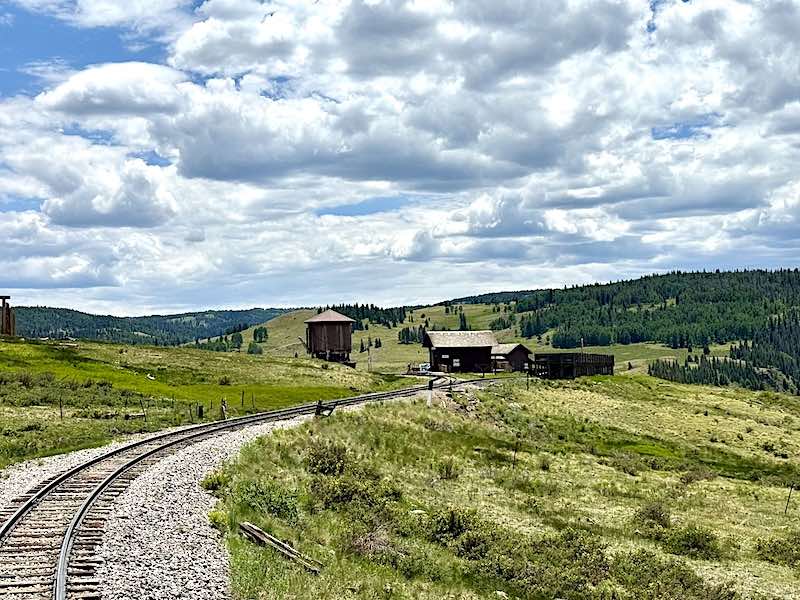

Departing Ozier, Colorado, on the return trip ot Chama, New Mexico
Departure from Osier
As soon as I heard the four prolonged whistle blasts from Engine 488 at Ozier, I realized we would be departing Chama in five minutes. Nearly all the other passengers were already on the train, while I remained outside our rail car to capture a few final photographs. Upon hearing two long blasts, I understood that the train was about to leave, prompting me to board quickly.
Return Journey Conversations
My fondest memories from my journey on the Cumbres and Toltec Scenic Railroad were made in the Dining Hall and during the return trip to Chama. Having taken numerous photographs and being aware of what to anticipate on the way back, I discovered that I had ample opportunity to converse with many of my fellow travelers. The majority were enthusiasts of railway excursions, relishing experiences that involved steam‑powered locomotives.
Many had traveled on several of the renowned trains across the Western United States, yet they often felt compelled to return for another ride on the Cumbres and Toltec. I was struck by their extensive knowledge of historical trains and railway routes, as well as their continued enthusiasm for seeking out the next great ride. Some had only experienced the Cumbres and Toltec a handful of times, while one gentleman had ridden it more than 50 times.
They enjoyed the picturesque views, but primarily, they cherished the nostalgia of returning to the leisurely travel experiences of their youth, when train travel was common and the joy of the journey was shared by all.


The coal tipple at Chama Station, where coal is loaded onto the coal car
Preservation of the Railroad
The Cumbres and Toltec Scenic Railroad is a survivor of an age when steam engines dominated the railways. Throughout its history, the railroad experienced numerous ups and downs influenced by economic conditions, including the cessation of federal silver purchases, the introduction of new modern locomotives, the Great Depression, and the discovery of oil and gas in the Four Corners area encompassing New Mexico, Colorado, Utah, and Arizona.
By 1967, the railroad had become obsolete for industrial purposes and was on the verge of being abandoned. Fortunately, in July 1970, the states of New Mexico and Colorado established a bi‑state commission to investigate ways to preserve the railroad.
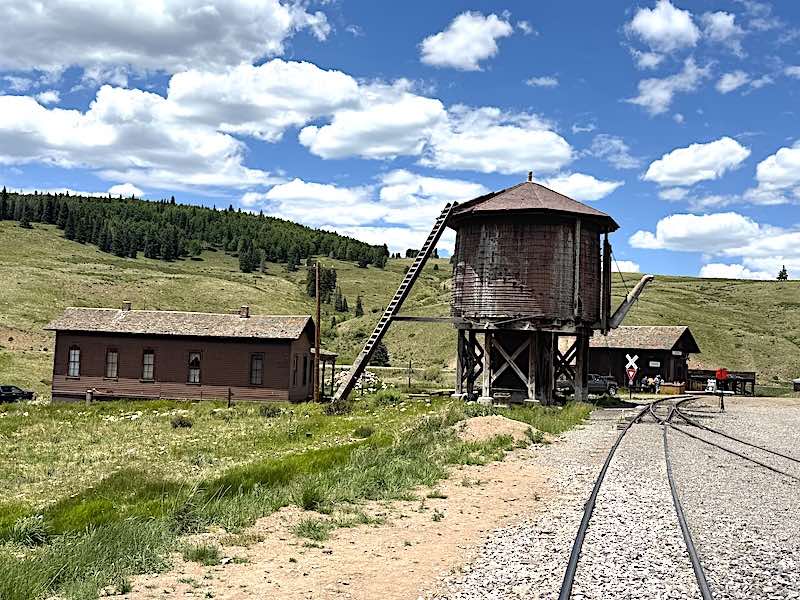

A water tower and historic buildings at Ozier Station
Commission and Friends
In 1971, the Cumbres and Toltec Scenic Railroad was established, leading to the formation of the Cumbres and Toltec Scenic Railroad Commission to oversee its operations. The commission engaged third‑party rail operators for railway operations until 2012, at which point they decided to collaborate with two organizations for the management of the tourist railway. Since 2012, the Cumbres Toltec Operating, LLC has taken on the responsibility of operating the tourist trains and maintaining the rolling stock and facilities.
Established in 1988, the Friends of the Cumbres and Toltec Scenic Railroad, Inc., has focused on the preservation, restoration, and interpretation of the historic railroad cars and structures. Up‑to‑date information regarding the railroad is available on their website (https://cumbrestoltec.com/), which includes a list of excursions, special trips, and service classes. Additionally, the site offers descriptions of the locomotives and equipment, resources to assist in planning your visit to either Chama or Antonito, and a link to download their app.


Ozier, Colorado, the lunch stop for the Cumbres and Toltec Scenic Railroad
Volunteers and Events
The non‑profit Friends of the Cumbres and Toltec Scenic Railroad is a unique organization comprised of members, volunteers, and donors who are committed to the stewardship of the railroad. Numerous volunteers are devoted to maintaining the property, interpreting the railroad’s history, and archiving its historical assets, including a vast collection of photographs. Members participate in special events such as the Moonlight and Wine Train excursion, the fall Photo Charter (which occurs after the regular season concludes), and summer work sessions focused on restoring the rolling stock and historic structures.
On the day of my visit, I greeted many of these volunteers who had traveled from various parts of the country. A number of the docents on the trains and in the railyards are also volunteers who assist in supporting the train operation.


The author at standing beside Steam Engine 488 at Chama Station
Final Reflections
The majestic power of the Steam Engine 488, the enchanting landscapes of the San Juan Mountains, and the unforgettable individuals I encountered made my journey on the Cumbres and Toltec Scenic Railroad truly remarkable. I lament the fact that I could not experience the segment of the railway from Antonito to Ozier. With notable features such as Phantom Curve, Mud Tunnel, Whiplash Curve, Hangman’s Trestle, Toltec Gorge, and Lava Loop, it is difficult to shake the feeling that I missed out on some extraordinary sights.
Nevertheless, I did partake in a portion of the history of the American West and experienced the nostalgia of traveling by rail during the era when steam engines dominated and there were no barriers to westward expansion. Every day from late spring through early fall, the collaborative efforts of the states of New Mexico and Colorado, in conjunction with the staff, volunteers, and supporters of the Cumbres and Toltec Railway, unite to offer visitors the opportunity to engage in an authentic experience from America’s history. Should you find yourself traveling through Albuquerque, the San Luis Valley, the San Juan Mountains, or the Four Corners region of the Western United States, indulge in a trip back to the golden age of steam railways by booking passage on the Cumbres and Toltec Scenic Railroad.
